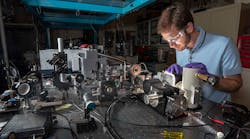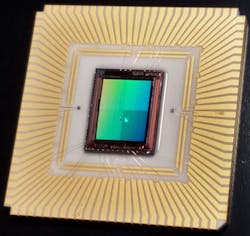A team of researchers at Sandia National Laboratories has developed small, gold antennas that let IR cameras and sensors “see” clearer pictures of thermal radiation for everything from stars and galaxies to people, buildings, and items passing through security.
The team developed a nanoantenna and a detector that boost the signal of an IR camera by a factor of three and improve image quality by reducing dark current, a major component of image noise, by a factor of 10 to 100.
Thermal cameras and sensors have been around for 50 years, but the traditional design of the detector that sits behind the camera lens or a sensor’s optics seems to be reaching its performance limits, according to Sandia researchers David Peters. He says that improving the sensitivity of IR detectors is important for both Sandia’s national security work and for other uses, such as astronomical research.
The sensitivity and image quality of IR detectors usually depend on a thick layer of detector material that absorbs incoming heat and turns it into an electrical signal that can be collected and converted into an image. The thickness of the detector layer determines how much heat can be absorbed and read by the camera, but thick layers have drawbacks.
Nanoantenna-enabled IR detector built at Sandia National Lab on an assembled focal plane array will be used with a thermal infrared camera. The gold nanoantennas are so small they aren’t visible on top of the detector array. (Courtesy: Sandia National Lab)
“The detector material is always spontaneously creating electrons that are collected and add noise to the image, which reduces image quality,” Peters explains. “This phenomenon, called dark current, increases along with the thickness of the detector material. So, the thicker the material, the more noise it creates in images.”
The research team’s new detector design does away with the thick layers and instead uses a subwavelength nanoantenna, a patterned array of gold square or cross shapes that concentrates light on a thinner layer of detector material. This design uses just a detectors fraction of a micron thick. Traditional IR detectors are 5 to 10 microns thick.
The nanoantenna helps detectors see more than 50% of an object’s infrared radiation while also reducing image distortion caused by dark current. Current detectors can only see about 25% of infrared radiation. The nanoantenna could also be part of new detectors not possible with existing technology.
“For example, with nanoantennas, it’s possible to expand the amount of information acquired in an image by controlling the spectral response at the pixel level,” Peters says.
The team makes the nanoantenna-enabled detectors by slightly altering the usual process for making IR detectors. It starts by “growing” the detector material on top of a thin wafer. The detector material is then flipped onto a layer of electronics that read the signals collected by the nanoantenna and detector layer. After discarding the wafer, a tiny amount of gold is applied to create a patterned nanoantenna layer on top of the detector material.
“We have proven this concept and the technology is ready to be commercialized,” says Peters. “ This concept can be applied to different detector types, so there’s an opportunity for manufacturers to combine this technology with their detectors.”


